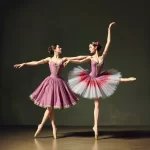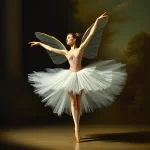Ballet: La Vivandière (Markitenka) (Cesare Pugni, 1844)

Introduction
Ballet, an art form that combines music, dance, and storytelling, has produced numerous masterpieces over the centuries. One such gem is “La Vivandière” (also known as “Markitenka”), a ballet composed by Cesare Pugni in 1844. Choreographed by Arthur Saint-Léon, this ballet premiered on May 23, 1844, at Her Majesty’s Theatre in London. “La Vivandière” is a one-act ballet that tells a charming and romantic story set against the backdrop of military life, featuring themes of love, bravery, and camaraderie.
Historical Background
Creation and Development
“La Vivandière” was created during a period of significant artistic and social change in Europe. The mid-19th century was marked by the Romantic movement, which emphasized emotion, nature, and individualism. This cultural backdrop influenced the creation of many ballets that focused on romantic and fantastical themes.
The inspiration for “La Vivandière” came from the figure of the vivandière, a woman who accompanied soldiers during campaigns, providing them with food, drink, and other necessities. This character was a popular figure in literature and folklore, symbolizing both nurturing and bravery. The collaboration between choreographer Arthur Saint-Léon and composer Cesare Pugni was crucial in bringing this ballet to life. Saint-Léon, known for his innovative choreography, worked closely with Pugni to create a seamless blend of music and dance that captured the essence of the story.
Premiere and Reception
“La Vivandière” premiered on May 23, 1844, at Her Majesty’s Theatre in London. The initial reception was overwhelmingly positive, with both critics and audiences praising the ballet for its engaging story, beautiful music, and innovative choreography. Notable early performances included revivals in Paris and St. Petersburg, where the ballet continued to garner acclaim.
Synopsis of the Ballet
“La Vivandière” is a one-act ballet that unfolds in a series of charming and lively scenes. The story revolves around a vivandière named Kathi and her romantic entanglements with a soldier named Hans.
Detailed Summary
The ballet opens with a bustling military camp where soldiers are preparing for battle. Kathi, the vivandière, is seen distributing food and drink to the soldiers, who are grateful for her presence. Among the soldiers is Hans, who is smitten with Kathi. Their mutual affection is evident, but their budding romance is complicated by the presence of a rival suitor, a pompous officer who also vies for Kathi’s attention.
As the story progresses, Kathi and Hans share tender moments, expressing their love through graceful pas de deux and lively ensemble dances. The ballet reaches its climax when the soldiers are called to battle. Kathi, determined to stay by Hans’ side, disguises herself as a soldier and joins the fight. Her bravery and resourcefulness are highlighted in a series of dramatic and action-packed scenes.
The ballet concludes with a triumphant return to the camp, where Kathi’s true identity is revealed. The soldiers celebrate their victory, and Kathi and Hans are finally united, their love stronger than ever. The finale is a joyous celebration of love, bravery, and camaraderie, underscored by Pugni’s uplifting and spirited music.
Musical Composition
Composer’s Role
Cesare Pugni, an Italian composer known for his prolific work in ballet music, played a pivotal role in the creation of “La Vivandière.” Pugni’s score is characterized by its lively rhythms, melodic richness, and ability to enhance the narrative and emotional depth of the ballet. His music provides a perfect complement to Saint-Léon’s choreography, capturing the essence of each scene and character.
Musical Themes and Motifs
The score of “La Vivandière” features several recurring musical themes and motifs that help to unify the ballet and underscore its key moments. For example, Kathi’s theme is a light and playful melody that reflects her nurturing and spirited nature, while Hans’ theme is more robust and heroic, highlighting his bravery and determination. These musical motifs are woven throughout the ballet, enhancing the emotional impact of the story.
Famous Recordings and Performances
Over the years, “La Vivandière” has been performed by numerous ballet companies around the world, and several recordings of its music have been made. Notable performances include those by the Bolshoi Ballet and the Royal Ballet, both of which have brought their unique interpretations to the ballet. These performances have helped to keep Pugni’s music alive and accessible to new generations of ballet enthusiasts.
Choreography and Dance
Choreographer’s Vision
Arthur Saint-Léon, a renowned choreographer of the Romantic era, brought his unique vision and style to “La Vivandière.” Known for his innovative use of mime and character dance, Saint-Léon sought to create a ballet that was both entertaining and emotionally resonant. His choreography for “La Vivandière” is characterized by its lively ensemble dances, intricate pas de deux, and expressive mime sequences that convey the story’s emotional nuances.
Signature Dance Numbers
One of the most iconic dance numbers in “La Vivandière” is the pas de deux between Kathi and Hans, which showcases their romantic connection through graceful lifts, turns, and synchronized movements. Another standout moment is the ensemble dance in the military camp, where the soldiers’ camaraderie and Kathi’s nurturing presence are highlighted through lively and energetic choreography.
Notable Interpretations
Over the years, different productions of “La Vivandière” have brought their unique interpretations to the choreography. Some have emphasized the ballet’s comedic elements, while others have focused on its romantic and dramatic aspects. Notable interpretations include those by the Paris Opera Ballet and the Mariinsky Ballet, both of which have added their own stylistic touches to Saint-Léon’s original choreography.
Characters and Roles
Main Characters
- Kathi: The vivandière, a nurturing and spirited woman who provides for the soldiers and falls in love with Hans. Her character is central to the ballet’s themes of love and bravery.
- Hans: A brave and loyal soldier who is smitten with Kathi. His character represents the ideal of the heroic and devoted lover.
Supporting Characters
- The Officer: A pompous and rival suitor who vies for Kathi’s attention, adding a comedic element to the story.
- Soldiers: The ensemble of soldiers who provide a lively backdrop to the main characters’ romance and adventures.
Famous Dancers
Over the years, many notable dancers have portrayed the roles of Kathi and Hans. Some of the most famous include Fanny Cerrito, who originated the role of Kathi, and Lucien Petipa, who was the first to dance the role of Hans. Their performances set a high standard for future interpretations of these characters.
Cultural and Artistic Impact
Influence on Ballet and Dance
“La Vivandière” has had a lasting impact on the world of ballet and dance. Its innovative choreography and engaging story have influenced many subsequent works, and its themes of love and bravery continue to resonate with audiences. The ballet’s success also helped to solidify the collaboration between choreographers and composers as a crucial element of ballet production.
Cultural Significance
The character of the vivandière has become a cultural icon, representing both nurturing and bravery. “La Vivandière” has been referenced in literature, theater, and other art forms, highlighting its enduring cultural significance. The ballet’s themes of love and camaraderie continue to resonate with audiences, making it a timeless classic.
Legacy and Revivals
“La Vivandière” has been revived numerous times since its premiere, with each production bringing its unique interpretation to the ballet. Major revivals include those by the Bolshoi Ballet and the Royal Ballet, both of which have helped to keep the ballet alive and relevant. Modern adaptations have also been made, incorporating contemporary elements while staying true to the original story and choreography.
Iconic Productions
Historic Productions
Some of the most famous historical productions of “La Vivandière” include its original premiere at Her Majesty’s Theatre in London and subsequent revivals in Paris and St. Petersburg. Key figures involved in these productions include Fanny Cerrito and Lucien Petipa, whose performances set a high standard for future interpretations.
Contemporary Productions
Recent productions of “La Vivandière” have brought new life to the ballet, incorporating modern elements while staying true to the original story and choreography. Notable contemporary productions include those by the Bolshoi Ballet and the Royal Ballet, both of which have added their unique stylistic touches to the ballet.
Production Design
The set, costume, and lighting design in various productions of “La Vivandière” have played a crucial role in bringing the story to life. Traditional productions often feature period-appropriate costumes and sets that evoke the military camp setting, while modern productions may incorporate contemporary design elements to add a fresh perspective to the ballet.
Critical Reception and Reviews
Initial Critical Response
At the time of its premiere, “La Vivandière” received overwhelmingly positive reviews from critics and audiences alike. The ballet was praised for its engaging story, beautiful music, and innovative choreography. Critics highlighted the seamless collaboration between Saint-Léon and Pugni as a key factor in the ballet’s success.
Modern Reviews
Contemporary critics and audiences continue to appreciate “La Vivandière” for its timeless themes and artistic excellence. Modern reviews often highlight the ballet’s historical significance and its enduring appeal. The ballet remains a popular choice for ballet companies around the world, with each new production bringing fresh interpretations to the classic story.
Fun Facts and Trivia
Behind-the-Scenes Stories
One interesting anecdote from the original production of “La Vivandière” involves Fanny Cerrito, who played the role of Kathi. Cerrito was known for her incredible technical skill and expressive dancing, and her performance in “La Vivandière” was no exception. During one rehearsal, she reportedly improvised a series of intricate steps that were so impressive that Saint-Léon decided to incorporate them into the final choreography.
Notable Performers
Over the years, many famous dancers have been associated with “La Vivandière.” In addition to Fanny Cerrito and Lucien Petipa, other notable performers include Alicia Markova, who brought her unique interpretation to the role of Kathi, and Rudolf Nureyev, who added his own flair to the role of Hans.
Trivia
- “La Vivandière” is sometimes referred to as “Markitenka,” which is the Russian word for vivandière.
- The ballet’s original choreography by Saint-Léon included a unique combination of classical ballet and character dance, which was innovative for its time.
- Cesare Pugni composed over 300 ballets during his career, but “La Vivandière” remains one of his most beloved works.
Conclusion
Summary of the Ballet’s Importance
“La Vivandière” is a significant work in the world of ballet, known for its engaging story, beautiful music, and innovative choreography. The collaboration between Arthur Saint-Léon and Cesare Pugni resulted in a timeless classic that continues to captivate audiences around the world. The ballet’s themes of love, bravery, and camaraderie resonate with viewers, making it a beloved piece in the ballet repertoire.
Final Thoughts
“La Vivandière” is a testament to the power of collaboration and artistic vision. Its enduring popularity is a testament to the skill and creativity of its creators, as well as the universal appeal of its story. Whether you are a seasoned ballet enthusiast or a newcomer to the art form, “La Vivandière” is a must-see performance that offers a delightful blend of music, dance, and storytelling.
FAQ
What is the central theme of this ballet?
The central theme of “La Vivandière” is love and bravery, set against the backdrop of military life. The ballet explores the romantic relationship between Kathi, the vivandière, and Hans, a soldier, highlighting themes of camaraderie and heroism.
Who are the main characters in this ballet?
The main characters in “La Vivandière” are Kathi, the vivandière, and Hans, a soldier. Kathi is a nurturing and spirited woman who provides for the soldiers, while Hans is a brave and loyal soldier who falls in love with Kathi.
What is the most famous dance number in this ballet?
One of the most famous dance numbers in “La Vivandière” is the pas de deux between Kathi and Hans. This dance showcases their romantic connection through graceful lifts, turns, and synchronized movements.
How long does a typical performance of this ballet last?
“La Vivandière” is a one-act ballet, and a typical performance lasts approximately 30 to 40 minutes.
Are there any modern adaptations of this ballet?
Yes, there have been several modern adaptations of “La Vivandière.” Contemporary productions often incorporate modern design elements and stylistic touches while staying true to the original story and choreography.
Why is this ballet considered important in the history of dance?
“La Vivandière” is considered important in the history of dance due to its innovative choreography, engaging story, and beautiful music. The collaboration between Arthur Saint-Léon and Cesare Pugni set a high standard for future ballets, and the ballet’s themes of love and bravery continue to resonate with audiences today.





